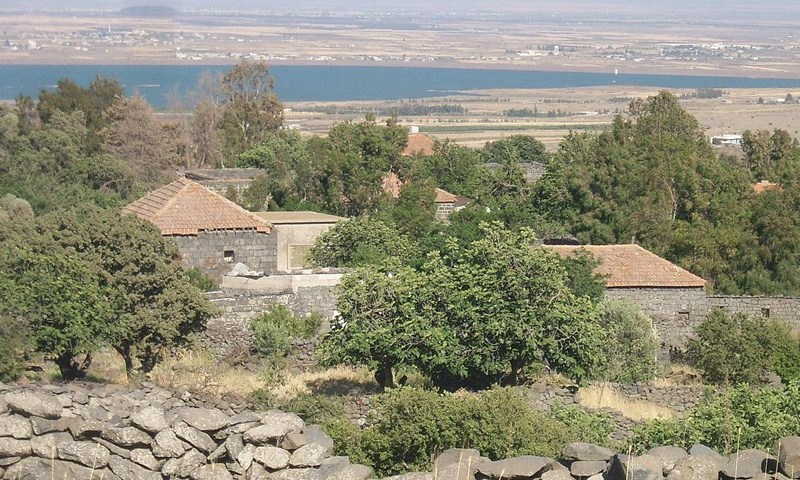



In the southern countryside of Quneitra, 11 kilometers (6.8 miles) from the city, within the demilitarized buffer zone with Israel, the village of Bariqa preserved its beauty despite years of fighting and immigration of its residents.
After the Syrian regime retook control of the south-western province of Quenitra and its villages in 2018, some people returned to their village, Bariqa, after years of displacement resulted from the war, to repair their homes and rehabilitate the infrastructure in an attempt to bring the village back to its “ideal state.” The village was chosen as one of the best villages 12 years ago.
On the black basalt stones, houses with red-tiled roofs were built. “Bariqa was one of the most beautiful villages in Quneitra before,” said the social researcher “Abu al-Bara,” from the middle Quneitra countryside, “It dates back to the last quarter of the ninth century.”
In Bariqa, monuments are dating back to the Hellenistic era, including carved stones, columns, Greek inscriptions, decorations of crosses and roses, and stone arches.
The village was regarded as a tourist attraction, with forests and trees, such as oaks, and hawthorn surrounded by dams, such as the dams “Bariqa,” and “Kodna,” at an altitude of 900 meters above sea level. Bariqa has a relatively moderate climate; mild to warm summers and cool to cold winters.
Circassians immigrating from the Caucasus in Russia settled in the village of Bariqa for the first time in 1879. At that time, it had nothing but monuments, on which the inhabitants built their homes with mudbricks.
According to the last census conducted more than ten years ago, 1,350 persons live in Bariqa. During these years, they were forced to experience displacement, as they did before due to the Israeli occupation in 1967, before returning after the armistice agreement during the seventies.
In 2008, the village people decided to prevent the sale of tobacco products, and they cooperated to preserve its beauty, which prompted the media outlets to shed light on it and called it “the Model Village.”
Regarding the reason for naming the village as “Bariqa,” the people mentioned two reasons: the first is that the village was named after a Roman commander who resided in the area. He was called “Bariqa,” and the second is that the village was named after the excessive amounts of lightning and thunder in the village.
For decades, “Abu Anas Goka” has kept his work and traditions in his village. “Agriculture is the defining characteristic of the village people,” the sixtieth man told Enab Baladi, noting that the seeds planted in the village were carried by their ancestors with them from the “Caucasus.”
“With their knowledge of the region’s weather, our ancestors brought with them seeds f non-flowering plants that cope with the harsh climate after they were forcibly displaced from Russia to Syria’s Quneitra,” Abu Anas Goka said, speaking of the white berries, grapevines, walnut, and fig trees. He added, “Nowadays, they grow olives, apples, pomegranates, and cherries, in addition to winter crops such as cereals and pulses in Quneitra.”
Abu Anas Goka has another profession, beekeeping, just like many of those who are famous for their work in the village, including honey producers and breeders of animals such as cows, sheep, chicken, and ducks.
Residents of the village maintain their Circassian traditions and customs of marriage, family meetings, and guests’ hospitability. The Circassian people are known for abstaining from a consanguineous marriage and facilitating the bride’s dowry payments, which were set 60 years ago and remain as they are today: 500 SYP (0.1 USD) is paid at the signing of the marriage contract, and 1,000 SYP (0.3 USD) is for the deferred, considering the dowry merely a symbol of the marriage contract.
The Circassians in Syria hold a huge celebration in honor of guests coming from neighboring villages or successful students or upon the return of absentee, serving tasty traditional Circassian food and with lots of dancing.
There are several dances performed by Circassians, including the “Qafe”—which is performed by a Circassian man and woman in wedding ceremonies—Sheshen— a fast dance reminiscent of the battles and wars they fought—Wygg, Zafako, a calm dance for old people, and other dances. Dance occupies an important place or is seen as a defining part of Circassian people’s culture.
Today, after the war, which forced many of Bariqa’s residents to suffer displacement for seven years, few stayed in Bariqa. In actuality, a large part of Bariqa’s residents headed to Russia and Turkey. Yet, those who stayed and returned to their village still maintain the rituals and traditions.
if you think the article contain wrong information or you have additional details Send Correction